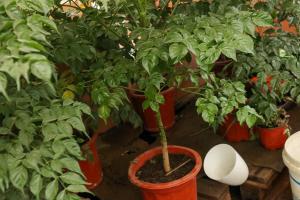What Causes Black Spots on Tomato Plant Leaves
Tomatoes are a popular vegetable that is grown in many regions of the world. However, they are susceptible to a number of problems, including black spots on the leaves. These spots can be caused by a variety of factors, including fungal or bacterial diseases, pests, and environmental factors. In this article, we will discuss the causes of black spots on tomato plant leaves and how to prevent or treat them.
Fungal Diseases
Fungal diseases are one of the most common causes of black spots on tomato plant leaves. There are several types of fungi that can infect tomato plants, including Septoria leaf spot, early blight, and late blight. These fungi can spread quickly and cause significant damage to the plant if left untreated.
Septoria leaf spot is characterized by dark brown or black spots on the lower leaves of the tomato plant. The spots may be circular or irregular in shape and can range in size from small specks to large blotches. Early blight, on the other hand, causes dark brown or black spots on the older leaves of the plant. The spots may have a target-like appearance with concentric rings of alternating light and dark areas. Late blight causes black spots on the leaves and can also affect the stems and fruit of the plant.
To prevent fungal diseases from infecting your tomato plants, it is important to practice good sanitation practices such as removing infected leaves and using clean tools. Additionally, you can use fungicides to prevent or treat fungal diseases. However, it is important to read the label and follow the instructions carefully to avoid damaging the plant or exposing yourself to harmful chemicals.
Bacterial Diseases
Bacterial diseases are another common cause of black spots on tomato plant leaves. One of the most common bacterial diseases that affect tomato plants is bacterial spot. This disease causes dark, water-soaked spots on the leaves that may later turn black. The spots may also appear on the stems and fruit of the plant.
Bacterial diseases can be difficult to control, and there are no effective treatments once the plant has been infected. To prevent bacterial diseases, it is important to practice good sanitation practices such as using clean tools and avoiding overhead watering. Additionally, you can use copper-based fungicides to reduce the spread of bacterial diseases. However, these fungicides can be toxic to some beneficial insects, so it is important to use them sparingly.
Pests
Pests can also cause black spots on tomato plant leaves. One of the most common pests that affect tomato plants is the tomato fruitworm. This pest feeds on the foliage of the plant, causing black spots and holes in the leaves. Other pests that can cause black spots on tomato plant leaves include aphids, whiteflies, and spider mites.
To prevent pests from damaging your tomato plants, it is important to keep the plants healthy and well-fed. Additionally, you can use insecticidal soaps or natural remedies such as neem oil to control pests. However, it is important to use these remedies carefully and sparingly to avoid harming beneficial insects such as honeybees and ladybugs.
Environmental Factors
Finally, black spots on tomato plant leaves can also be caused by environmental factors such as sunscald or physical damage. Sunscald occurs when the leaves of the tomato plant are exposed to too much sunlight, causing the leaves to develop black spots or patches. Physical damage, on the other hand, can occur when the leaves are bruised or broken.
To prevent environmental factors from damaging your tomato plants, it is important to provide proper care and protection. For example, you can provide shade for the plants during the hottest part of the day or cover them with a protective netting to prevent pests from infesting them.
Conclusion
Black spots on tomato plant leaves can be caused by a variety of factors, including fungal or bacterial diseases, pests, and environmental factors. To prevent or treat black spots on tomato plant leaves, it is important to practice good sanitation practices, use fungicides or insecticides as needed, and provide proper care and protection for the plants. With careful attention, you can ensure that your tomato plants remain healthy and productive throughout the growing season.

 how many times do yo...
how many times do yo... how many planted tre...
how many planted tre... how many pine trees ...
how many pine trees ... how many pecan trees...
how many pecan trees... how many plants comp...
how many plants comp... how many plants can ...
how many plants can ... how many plants and ...
how many plants and ... how many pepper plan...
how many pepper plan...
































